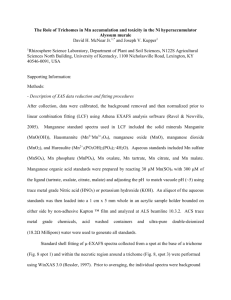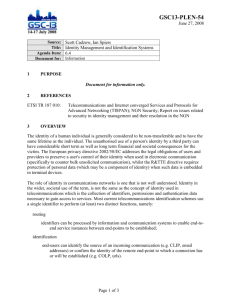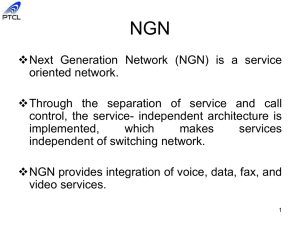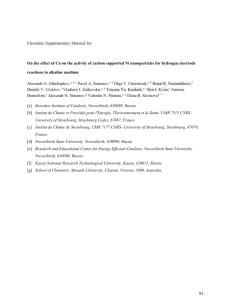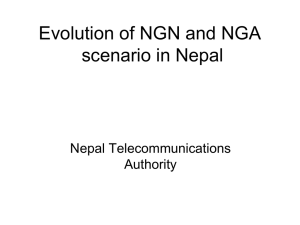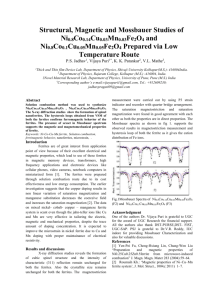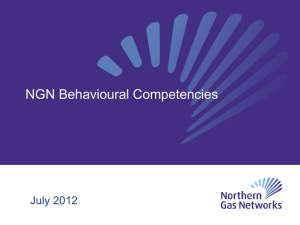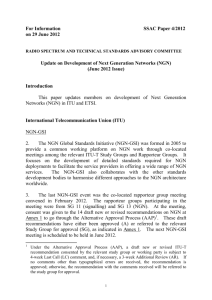NGN - Etestseries.in
advertisement
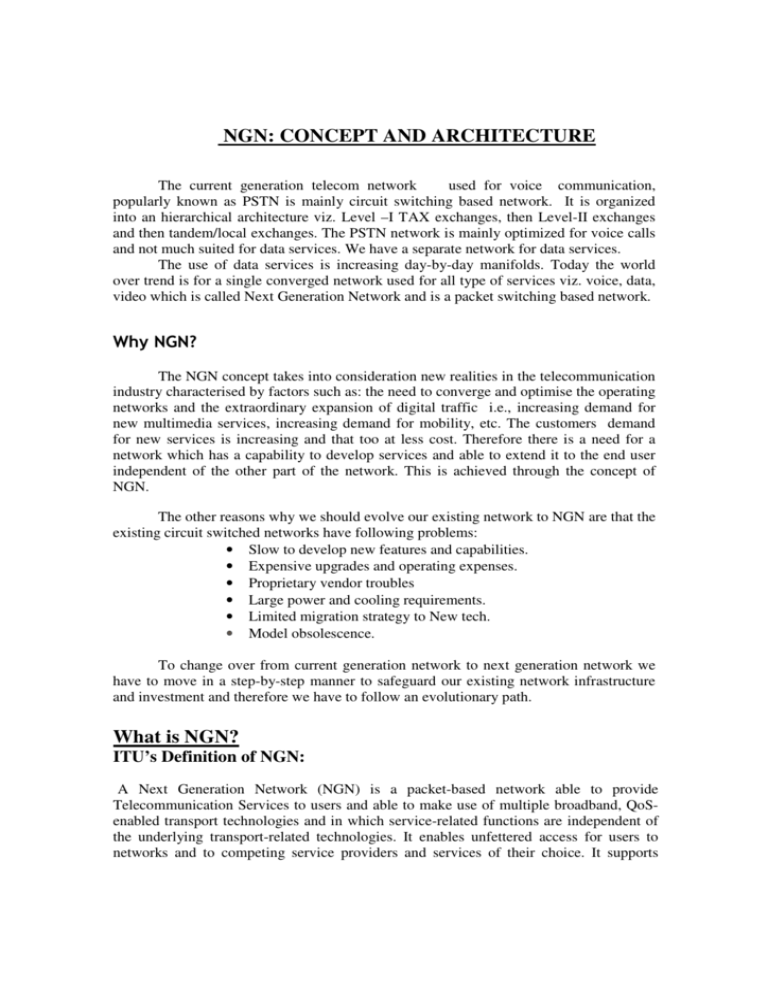
NGN: CONCEPT AND ARCHITECTURE The current generation telecom network used for voice communication, popularly known as PSTN is mainly circuit switching based network. It is organized into an hierarchical architecture viz. Level –I TAX exchanges, then Level-II exchanges and then tandem/local exchanges. The PSTN network is mainly optimized for voice calls and not much suited for data services. We have a separate network for data services. The use of data services is increasing day-by-day manifolds. Today the world over trend is for a single converged network used for all type of services viz. voice, data, video which is called Next Generation Network and is a packet switching based network. Why NGN? The NGN concept takes into consideration new realities in the telecommunication industry characterised by factors such as: the need to converge and optimise the operating networks and the extraordinary expansion of digital traffic i.e., increasing demand for new multimedia services, increasing demand for mobility, etc. The customers demand for new services is increasing and that too at less cost. Therefore there is a need for a network which has a capability to develop services and able to extend it to the end user independent of the other part of the network. This is achieved through the concept of NGN. The other reasons why we should evolve our existing network to NGN are that the existing circuit switched networks have following problems: • Slow to develop new features and capabilities. • Expensive upgrades and operating expenses. • Proprietary vendor troubles • Large power and cooling requirements. • Limited migration strategy to New tech. • Model obsolescence. To change over from current generation network to next generation network we have to move in a step-by-step manner to safeguard our existing network infrastructure and investment and therefore we have to follow an evolutionary path. What is NGN? ITU’s Definition of NGN: A Next Generation Network (NGN) is a packet-based network able to provide Telecommunication Services to users and able to make use of multiple broadband, QoSenabled transport technologies and in which service-related functions are independent of the underlying transport-related technologies. It enables unfettered access for users to networks and to competing service providers and services of their choice. It supports generalised mobility which will allow consistent and ubiquitous provision of services to users. < ITU-T Recommendation Y.2001 (12/2004) - General overview of NGN>. ETSI’s Definition of NGN As per ETSI NGN is a concept for defining and deploying networks, which due to their formal separation into different layers and planes and use of open interfaces, offers service providers and operators a platform, which can evolve in a step-by-step manner to create, deploy and manage innovative services. The following diagram depicts the concept of NGN. Current Gen networks Call Control Switching Interfaces SDH Transport with Overlay packets for data NGN Call Server IP/MPLS Gateways Common IP MPLS Transport In NGN basically the call control (i.e. signaling) and the switching is separated out in different layers and between these layers open interfaces are used. The call control functionality is realised by the component which is called call server or softswitch or media gateway controller and the interfaces to the existing PSTN switches is done with the help of media gateways for voice transport and by signaling gateways for signaling transport. For switching and transport of the packets existing IP/MPLS backbone is used. With NGN architecture the new and innovative services can be given very fast and cost effectively. Also the capital expenditure and operational expenditure come down drastically. The NGN is characterised by the following fundamental aspects: • • • • • • • • • • • • • • Packet-based transfer Separation of control functions among bearer capabilities, call/session, and application/service Decoupling of service provision from transport, and provision of open interfaces Support for a wide range of services, applications and mechanisms based on service building blocks (including real time/streaming/non-real time services and multi-media) Broadband capabilities with end-to-end QoS and transparency Interworking with legacy networks via open interfaces Generalised mobility Unfettered access by users to different service providers A variety of identification schemes which can be resolved to IP addresses for the purposes of routing in IP networks Unified service characteristics for the same service as perceived by the user Converged services between Fixed and Mobile networks Independence of service-related functions from underlying transport technologies Support of multiple last mile technologies Compliant with all Regulatory requirements, for example concerning emergency communications and security/privacy, etc. The general NGN Functional Reference Architecture is shown in Fig.1. In this architecture there are mainly two layers/ stratums: 1. Service Stratum: Dealing with the service/application and call control functions of the call. 2. Transport Stratum: Dealing with the transport or switching and access Functions of the call. The Network Access and Attachment Function (NAAF) is used for authentication and autherisation of the user. The Resource Admission and Control Function(RACF) is used for ensuring Quality of Service. NGN Functional Reference Architecture (NGN-FRA) 3 r Party Applications AN Service Stratum Application Functions User Profile Functions Other Multimedia Components … Streaming Services Service and Control Functions Other Networks PSTN / ISDN Emulation IP Multimedia Component &PSTN/ISDN Simulation including PSTN/ISDN Simulation Legacy Terminals Network Access Attachment Functions NAAF GW Customer Networks NGN Terminals End-user and Customer Terminal Functions Functions Access Functions Access Transport Functions Resource and Admission Control Functions RACF Edge Functions Core transport Functions Transport Stratum NNI UNI Fig. 1 Background: ITU-T’s NGN Work In 2003 a Joint Rapporteur Group bringing together experts from across all Questions of Study Group 13 was formed. The main subjects studied by the Joint Rapporteur Group on NGN (JRG-NGN) were: NGN requirements, the general reference model, functional requirements and architecture of the NGN, and evolution to NGN. The JRG-NGN produced two fundamental Recommendations, viz. Y.2001, General overview of NGN and Y. 2011, General principles and general reference model for next generation networks. In order to continue and accelerate NGN activities initiated by the JRG-NGN, ITU-T established a Focus Group on NGN (FGNGN) in May 2004. Focus Groups provide an effective and rapid response mechanism for progressing the work of the ITUT. The FGNGN addressed the urgent need for an initial suite of global standards for NGN. The FGNGN’s mandate was extended through November 2005 as it was clearly attracting significant participation and input from the membership. The results of the FGNGN (Release 1) provided the building blocks on which the world’s systems vendors and service providers can start to make the shift to NGN. Since the creation of FGNGN there has been an intensive schedule of meetings, about every two months, but more importantly there has been growing momentum in the work, and growth in participation and the number of contributions. Now this work is carried forward by ITU-T’s NGN-Global Standards Initiative (NGN-GSI), which encompasses all NGN work across ITU-T Study Groups. It has been implemented by co-located meetings of concerned Study Groups and Rapporteur Groups from the various study groups to jointly progress the work under the auspices NGN-GSI. The NGN Architecture Central to the NGN architecture is the Soft Switch, which is a call server that allows multiple application services to run concurrently. The Multi-service Gateway facilitates Voice, Video and Data services to be accessed by the customer via the feature rich edge. Typical features include Layer-2 and Layer-3 VPN services, VPLS services, Firewall services and Network Address Translation (NAT) services. The position of the Soft Switch, Service Gateways and Application Servers providing Multiple Services in NGN environment is shown in Figure 3. The NGN Architecture consists of several basic components – The Soft Switch, Application Servers, Media Servers, Network Gateways and Access Gateways with the IP-MPLS Packet Router Network providing the transport layer. The block schematic of NGN components and usage of key protocols are shown in Figure 4. The Soft Switch is shown at the centre. The SIP Signaling server provides signaling interface to IP End points in a Broadband environment. The Application and Media servers work in conjunction with the Soft Switch to deliver the specific application and the media related functions (such as anIVRS module) to the customer. The NGN network is interconnected to the PSTN network through Media Gateways, which are controlled by the Soft Switch. The capability to interconnect the soft switches with other soft switches either in one’s own network or in any other Service Provider’s network is done through Network Gateways. Fig 4 The Operations and Management of the Soft Switch require OSS – BSS systems, which facilitate service provisioning, service assurance and service billing. These are implemented alongside the Soft Switch. Having created a new network concept called the NGN, which can almost revolutionize the service delivering capability over multimedia (i.e. voice, video and data), an important aspect that should engage one’s attention is how to integrate existing investments in voice dominated Public Switched Telephone Network (PSTN) with NGN in a transparent way so that the overall service offerings are not perceived as being sourced from two networks – one a superior modern network and another that is a legacy. This is made possible through Media Gateways that form the intermediaries between the TDM based PSTN and the IP-based NGN. Media Gateways can broadly be classified into Trunking Gateways and Access Gateways. The Trunking Gateways provide connectivity to the Local Switches through standard SDH interfaces, typically over E1 or STM-1 lines. The Access Gateways provide interfaces to customers over TDM links. There is also the Signaling Gateway that connects the SS7 Signaling system in a PSTN Switch to the Soft Switch. Evolution of Present Networks to NGN: Related Issues The evolution of networks to NGNs must allow for the continuation of, and interoperability with, existing networks while in parallel enabling the implementation of new capabilities. Since the realisation and deployment of the NGN will be an evolutionary process, and not all networks will start from the same point, it is necessary to describe a variety of approaches. The high capital investment in the PSTN (public switched telephone network) means it must be one of the main work areas for studying evolution to the NGN. The resulting outputs describe possible ways of evolving the PSTN to become an NGN. These outputs provide steps for evolution of transport, management, signalling and control parts of the PSTN to the NGN. Other starting points, notably existing public land mobile networks (PLMNs), and associated transition scenarios are also under study. QoS (Quality of Service) The basic criterion for QoS evolution is ‘subjective user satisfaction’, e.g. speed, accuracy, reliability, and security. This involves identification of parameters that can be directly observed and measured at the point at which the service is accessed by users and network providers. Flexibility within the global end-to-end NGN architecture is essential to allow for each recognised operating agency’s different regulatory environment, service offerings, geographic span, and network infrastructure. These factors need to be taken into account when agreeing on parameters for, and levels of, QoS for NGN. Interoperability Considering that the NGN will involve a broad series of protocols (including various profiles) at both service and network levels, it is essential to ensure interoperability between different systems and networks. Security Security is as crucial to the NGN as it is in today’s network environment. The very wide scope of this topic, combined with the number of SDOs (standards development organisations) already involved, underlines the strategic importance of this subject. Within the NGN, security issues interrelate with architecture, QoS, network management, mobility, charging and payment. Security studies in NGN are addressing: o o o a comprehensive security architecture for NGNs the preparation of NGN operational security policy and guidelines NGN security protocols and APIs (application programming interface) Generalized Mobility NGN will give users and devices the ability to communicate and to access services irrespective of change of location or technical environment. The degree of service availability may depend on several factors, including access network capabilities, service level agreements between the user's home network and visited networks, etc. It includes the ability to communicate from various locations using a variety of terminal equipment, with or without service continuity while in transit or while changing access means. This includes recognition of the need to converge the previously distinct worlds of fixed and mobile telecommunications into a coherent whole. Service Capabilities and Architecture Work in this area will continue to: o o address the telecommunication service capabilities that the NGN should provide, maintaining separation between services and the networks they run on; and develop a suitable service architecture focused on the interfaces to support different business models and seamless communication in different environments. Backward compatibility with and the evolution from existing services and systems will be studied in order to meet the needs of end users and service providers.
